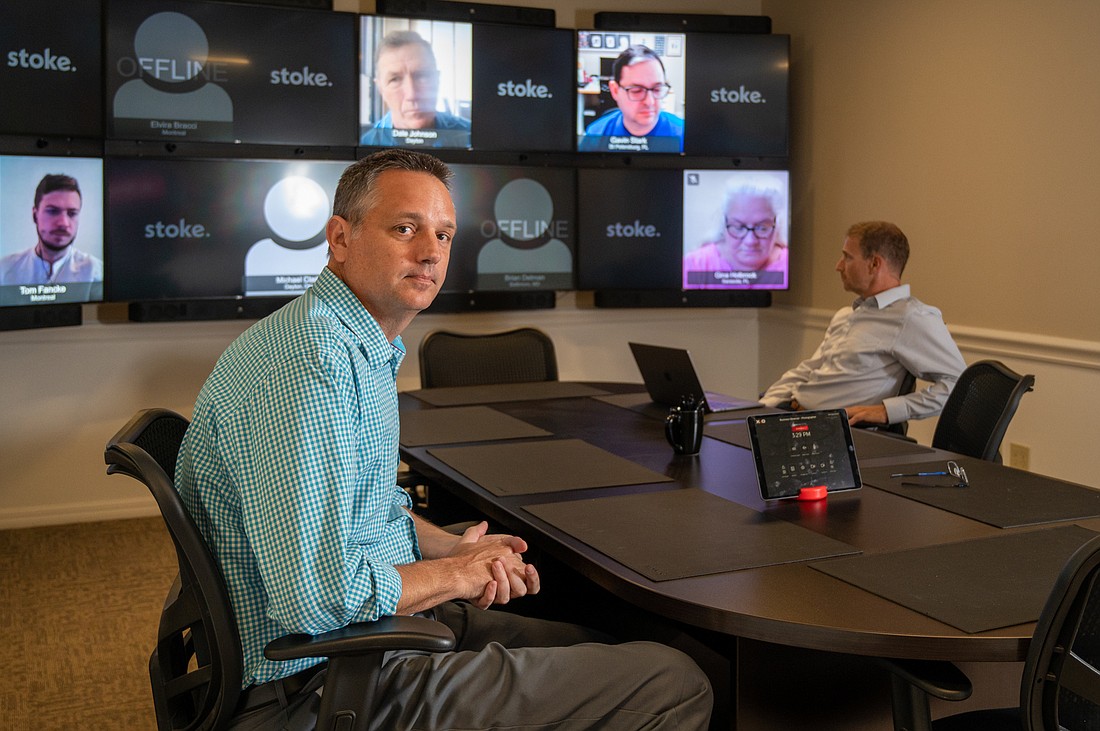- March 13, 2025
-
-
Loading

Hybrid schedules, where employees come into work a few days out of the week and work remotely the rest, are all the rage these days. But what about hybrid video conferencing?
That's the newest new thing, courtesy of the Stoke Collaboration Room in Sarasota. It's designed to host eight people in-person and 64 additional remotely. Sarasota-based Real Digital Media, in partnership with its sister company, X2O Media, debuted the room about four months ago during a soft launch. The room is inside Real Digital Media's office, at 1800 2nd Street, Suite 104, in downtown Sarasota.
“A lot of times, the people who have to lead presentations or training or conduct a class, they get Zoom fatigue,” Jason Broom, VP of marketing at Real Digital Media, says. “They don’t feel like they’re getting engagement.”
“The whole point of the room is to feel authentic engagement with the people who are remote,” he adds.
The technological components of the room include a large format touch display screen, remote presenter display that allows remote attendees to present to the room, a motion tracking camera and an audio receiver in the ceiling. The room provides four camera angles to allow for smooth transitions and full range of motion.
If at some point, a remote attendee switches to another tab or screen on their computer, an icon will appear alerting the in-person attendees or presenter that person is, perhaps, a little distracted. “It’s not really to narc on someone, but it’s to give the presenter an idea of who is really paying attention,” Broom says.
The original idea for the room was to create a multipurpose room that could be used as a classroom, boardroom, training center, meeting room or situation room. For example, if a large company wanted to bring 50 employees to a conference room somewhere to train them on a new product, the employer would be looking at airline tickets, hotel rooms and possible food costs. Now, Broom says, they can just rent the Stoke room for a couple of hours, have the engagement they’re looking for and save money in the process.
“Obviously, face-to-face is still very powerful for people,” Broom acknowledges, “but (so is) being able to quickly bring together 64 people and have a training session on a new product or HR guideline.”
Aside from immersive camera angles, the room is designed for content sharing from both in-room and remote participants, as well as annotation where every participant can share ideas on the same board.
The 17-by-25-foot room room can be configured into different layouts depending on the use, including a typical conference room, modular conference room, modular studio and a classroom layout. It can be rented out for two-hour, four-hour and eight-hour sessions. The two-hour session costs $1,000, four hours is $1,800 and the all-day session is $3,200.
“People have a predefined idea of what this is,” Broom says of the challenges he’s afraid the company will have. “If people are thinking they want video conferencing, this is not it. The challenge is not selling them on the room, but selling them off of video conferencing.”
In addressing this, Broom points to the annotation elements as well as the ability to create a tiny conference center. “There’s no scalable limits,” he says.
Broom adds that the goal of the room is to provide an authentic experience. “They come into the room and get energized,” he says of the feedback thus far. He notes remote participants will still have a remote experience, albeit a deeper one with the number of camera angles in the room.
“When (the presenter is) sitting, hunched over their desk at home trying to lead whatever presentation they’re giving, they don’t know who’s watching,” he says. “When they get energized, the people remotely get energized because (the presenter is) getting to act and use their hands.”
The other hurdle is figuring out if the collaboration room is worth the $1,000 for two hours compared to a free 30-minute Zoom call. Broom expects this to mainly impact smaller companies interested in using the room rather than large corporations.
The first-year goal is to get clients in to test the room.
Since it’s more of a side business under the parent entities, Broom says he and the team have time to figure out how to make it successful. So for now, they’re taking a slow roll to introducing it to the public. They’re currently trying to get the word out to local clients within an hour’s reach of the room. "We’re just trying to get people out to experience it first,” he says.
While Broom says three years is pretty far out to think about from a technology standpoint, he does hope they’ll be able to expand it nationwide by then. Another possibility is franchising.
For now, Broom says the feedback has been positive as guests can “see its potential.”
“The room,” he says, “should sell itself.”